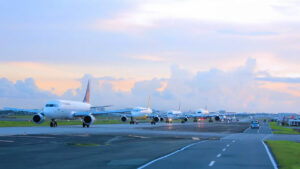THE CIVIL Aeronautics Board (CAB) will retain the passenger fuel surcharge at level 4 for October, keeping airline fuel charges steady for the third straight month.
At level 4, the passenger fuel surcharge will range between P117 and P342 for domestic flights, and between P385.70 and P2,867.82 for international flights originating from the Philippines.
For airlines collecting fuel surcharges in foreign currency, the applicable rate for the period will be P57.04 to the dollar, the CAB said in an advisory on Thursday.
Fuel surcharges are adjusted based on the movement of jet fuel prices, using the Mean of Platts Singapore (MOPS) benchmark.
According to the International Air Transport Association (IATA), the global average jet fuel price slipped by 0.1% to $89.33 per barrel week on week as of Sept. 12.
On an annual basis, the global average jet fuel price dropped 9.8%, IATA said.
In a June report, the trade association said airlines are projected to record a net profit of $36 billion this year, driven mainly by passenger revenues and steady jet fuel prices.
Jet fuel is expected to average $86 per barrel in 2025, below last year’s $99 average, translating to about $236 billion in fuel costs, or 25.8% of total airline operating costs.
Separately on Thursday, flag carrier Philippine Airlines (PAL), operated by PAL Holdings, Inc., said it will boost flights on key domestic routes starting October to capture anticipated demand during the peak travel season.
PAL said it will increase flights between Manila and Butuan to 21 from 14 weekly; Manila and Cagayan de Oro to 42 from 35; Manila and Cotabato to 14 from 11; and Manila and Legazpi to 28 from 21.
The flag carrier will also raise services between Manila and Tacloban to 25 from 21 flights weekly, while operating daily Manila-Siargao flights and 21 weekly Cebu-Siargao services.
By October, PAL will mount daily flights between Clark and Siargao, while offering 42 weekly flights between Manila and Boracay, seven weekly flights between Cebu and Boracay, 14 weekly Manila-Coron flights, and 14 and 21 weekly flights on the Clark-Coron and Cebu-Coron routes, respectively.
“For the peak season, PAL will operate a total of 1,154 weekly flights between Manila and key domestic destinations, with overall flight frequencies rising by 7%,” PAL Express President Rabbi Vincent L. Ang said in a statement.
The airline said it expects seat capacity out of Manila to expand by more than 14,000 seats due to the additional flights starting next month.
PAL is also set to launch a Cebu-Calbayog service on Oct. 26 to strengthen its Visayas and Mindanao hubs.
“This new service will provide travelers from Eastern Visayas direct access to Visayas and Mindanao, enhancing connectivity and convenience. We’re investing in Cebu as a strategic hub to help drive tourism and economic growth across the region,” Mr. Ang said.
For the January-to-June period, PAL carried 8.47 million passengers and operated 57,598 flights.
The flag carrier earlier said it is preparing to operate 22 brand-new aircraft in the coming years, starting with the delivery of the Airbus A350-1000 by yearend.
PAL is also expecting the delivery of additional A350-1000s and 13 A321neo regional aircraft starting in 2026, along with the arrival of 18 retrofitted Airbus A321ceo aircraft by October this year.
At the local bourse on Thursday, shares in PAL Holdings closed unchanged at P3.99 apiece. — Ashley Erika O. Jose

